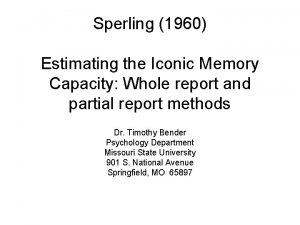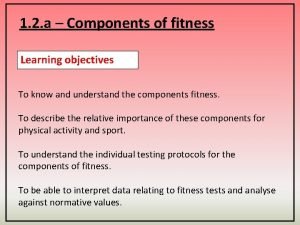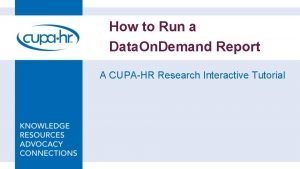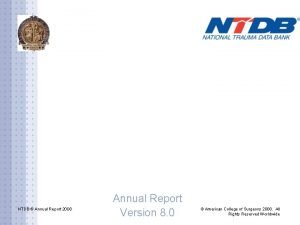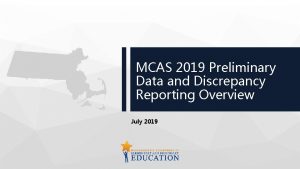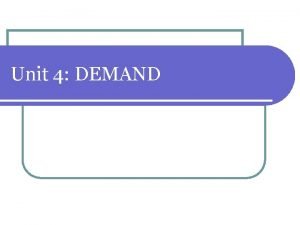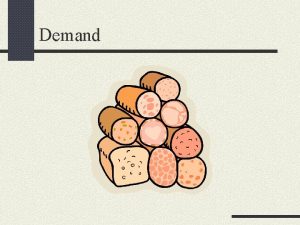How to Run a Data On Demand Report

























- Slides: 25

How to Run a Data. On. Demand Report A CUPA-HR Research Interactive Tutorial

What is Data. On. Demand (DOD)? • DOD is a subscription that gets you access to results and data tools from CUPA-HR Surveys. • An institution can purchase DOD for each survey: • • • Administrators in Higher Education Faculty in Higher Education Professionals in Higher Education Staff in Higher Education Two-Year Faculty in Higher Education Benefits in Higher Education

Ordering Data. On. Demand For pricing and ordering, visit: www. cupahr. org/surveys/dataondemand Click this information button to open the Data. On. Demand website now.

Log In to Surveys Online Click to see the login information window Click again to see the sign-in page

Navigate to Survey Reports Comparison groups and survey reports are your most used options. The Data. On. Demand menu lets you access comparison groups and survey reports. To learn to set up comparison groups, click here. To skip ahead to survey reports, click here.

Setting Up Your Comparison Groups The comparison group page lets you create or edit a group of institutions to benchmark against. Click this icon to open a DOD user webpage with tutorial videos on creating comparison groups.

Types of Comparison Groups Scroll down after choosing Comparison Group and you’ll see three group sets: Personal Groups – any group you’ve created yourself Shared Groups – personal groups created and shared by people at your institution Public Groups –ready-made groups created by CUPA-HR

Making a Comparison Group Available Clicking the + or – circle expands or closes each list. Put a check mark in the box next to the names of any group you want to make available for use in Survey Reports. After selecting a group with a check mark, always remember to click the Save Changes button.

Selecting a Survey Report After you’ve made sure your desired comparison groups have been checked and saved, you can click to access the survey reports menu.

Navigating the Survey Reports Menu The Survey Reports menu shows reports available for any survey data you subscribe to. Click on “See Descriptions of the Reports” to download the Data. On. Demand User Guide. Click on the image to the right to see how to open the menu and mouse-over report names to get more information.

Choose the Report That’s Right for You Benchmarking Position Salaries Demographic Salary Equity Comparisons Multi-Discipline Report Age Demographic Report Benchmarking Salary Increases Here are some common salary data needs, and the reports that may help. Trend Report Single-Discipline Report Ethnicity Demographic Report Prevailing Wage Report Gender Demographic Report Aggregated Positions Report Years in Position/Rank Report 2 -Digit Trend Report (for Faculty) Click here to open the DOD User Guide with more information on available reports.

Example: Administrator Multi-Position Report Example Strategic Question: “Is the pay for our top administrators competitive against our selected peer institutions? ” Click anywhere to proceed to how to choose the settings for this report. The Multi-Position Report can be used to compare median salaries for many positions at once. Have you chosen or set up your comparison group of peer institutions? To review, this button returns you to the Comparison Groups section of this tutorial.

Settings: Comparison Group Each DOD report has unique settings that can be selected. For this example, we’ll use a custom, personal group set up for Demonstration University’s peers. Click to see the Comparison Group options that are currently checked as available.

Settings: Year and Weighting Data years with available data for this report can be selected on the Year drop-down menu. Unweighted data tells you what the typical institution pays for a position. Weighted data tells you what the typical position incumbent is paid. Weighting can be selected, if desired. Unweighted is the default. See User Guide for more info

Settings: Output Format HTML PDF CSV Output Format lets you see results in HTML, as a PDF download, or as a CSV (Excel spreadsheet) file. Click once each time to see examples of the different formats.

Settings: Filter Outliers can be used to refine data if you suspect a few “very high” or “very low” salaries are impacting an average. CUPA-HR cleans extreme outliers from the data, but depending on your comparison group you may find additional filtering helpful. Don’t Filter is the default setting.

Settings: Additional Percentiles displays a set of salary percentiles in the report. Some users find percentiles helpful in determining salary ranges (e. g. , 40 -60 percentile range around the median). Percentiles may also give you a sense of the range or distribution of a data set.

Settings: Positions to Highlight lets you choose the way DOD compares your institution’s salaries to your comparison group. Click anywhere to see what these icons will look like on your report. This setting adds a highlight icon when your salaries are above or below the This salary is only 50. 7% of the median, specified setting. so it is marked with the “low” icon. This salary is 91. 6% of the median, so it is in normal range and not highlighted. This salary is 174. 0% of the median, so it is marked with the “high” icon.

Settings: Positions to Include lets you choose which positions appear in your report. Choose from reported positions, select all, or select none from this menu. These other options are user-created custom lists made by manually checking positions then clicking “Save Selection. ” They are automatically shared to all DOD users at your institution for quick access. Simply toggle the check box on positions you want to see. Click again to learn about the manual selection box. By default, only positions you reported for your institution in CUPA-HR surveys are selected. Click anywhere to see other options.

Settings: Annual Aging Factor Toggle the check box to apply aging to the data. When you run your report, salary aging information will appear in the report header and comparison data is adjusted. The Annual Aging Factor allows you to prorate salaries from the data collection date to any date before next year’s salary surveys are released. You can use our suggested rate, or enter your own. Click anywhere to see an example.

Settings: Run Your Report To get results, you click the Go to Report box once you’ve chosen all your settings. To review this example again, click here. Click anywhere to proceed to the Understanding Results section of this tutorial.

Understanding Results: The Report Your unique report header tells you: • The report you ran • Your institution • Comparison group you used • Comparison group size • Data year • Weighting settings • Salary effective date • Aging settings Click anywhere to proceed.

Understanding Results: Data Table The data results of your report appear in the table. For many reports, summary statistics are available. “Across All Positions Selected” summary statistics Statistics for each position Click anywhere to proceed.

Understanding Results: Strategy Recall the Example Strategic Question: “Is the pay for our top administrators competitive against our selected peer institutions? ” Make strategic comparisons right from the results. Click once each time to highlight the three key content areas. Your salaries Selected comparison group salaries Comparison ratios

Conclusion and Resources To restart at the beginning of this tutorial, click here. To download the DOD User Guide, click here. To visit the CUPA-HR site for DOD users, click here. Thank you for using our interactive tutorial. If you have feedback or questions, contact the Research Team by visiting the Ask Research page on our website: https: //www. cupahr. org/surveys/ask-research/
 Short run equilibrium
Short run equilibrium Run lola run butterfly effect
Run lola run butterfly effect Run lola run editing techniques
Run lola run editing techniques Short run vs long run economics
Short run vs long run economics Multirule plus
Multirule plus Perfect competition short run and long run
Perfect competition short run and long run Brigitta olsen
Brigitta olsen Lola rennt filmanalyse
Lola rennt filmanalyse Stochastic inventory model example
Stochastic inventory model example Measures to correct excess demand and deficient demand
Measures to correct excess demand and deficient demand Market demand curve
Market demand curve Dependent demand example
Dependent demand example Example ng demand schedule
Example ng demand schedule Dependent demand vs independent demand
Dependent demand vs independent demand Module 5 supply and demand introduction and demand
Module 5 supply and demand introduction and demand Demand forecasting managerial economics
Demand forecasting managerial economics Distinguish between individual demand and market demand
Distinguish between individual demand and market demand Inventory models for independent demand
Inventory models for independent demand Writing a status report
Writing a status report Sperling (1960)
Sperling (1960) Physical fitness test objectives
Physical fitness test objectives Cupa hr data on demand
Cupa hr data on demand National trauma data bank annual report 2020
National trauma data bank annual report 2020 Self-report method
Self-report method Biology mcas 2019
Biology mcas 2019 Sample qualitative data analysis report
Sample qualitative data analysis report



















